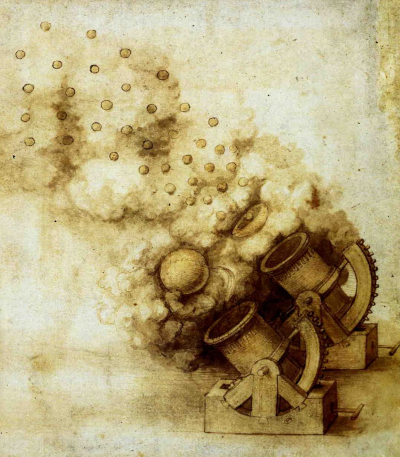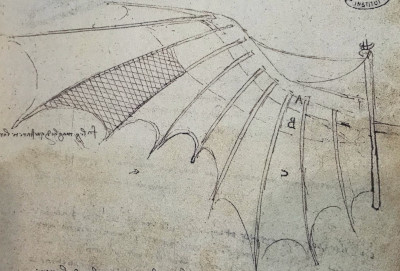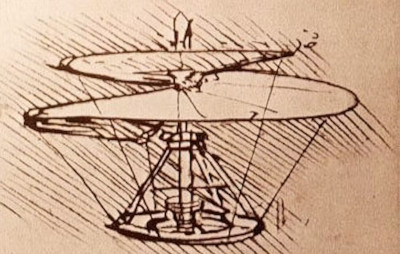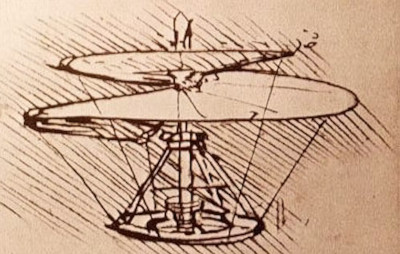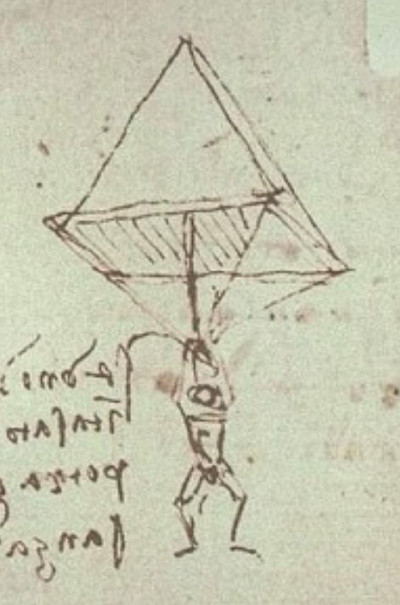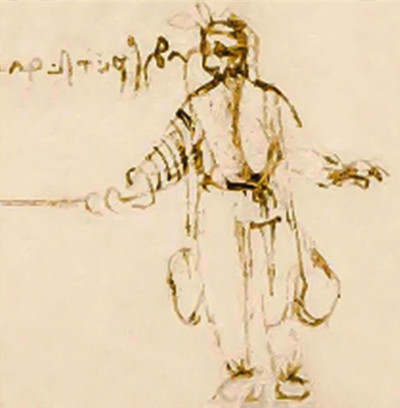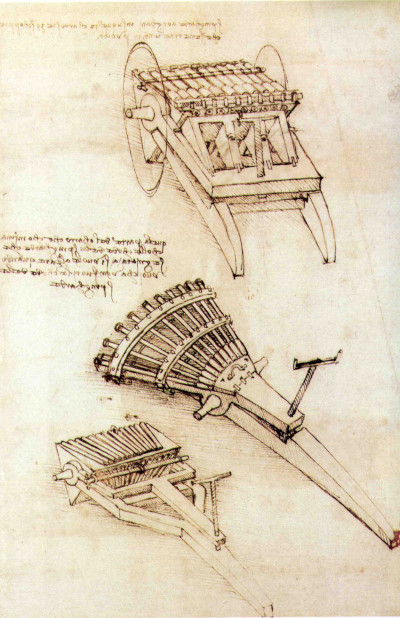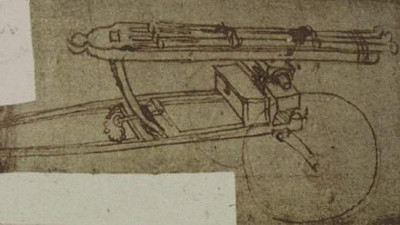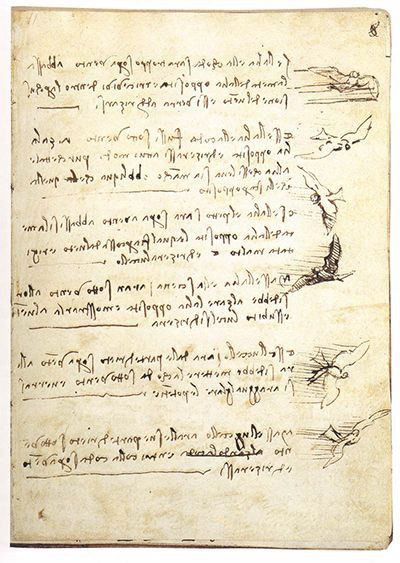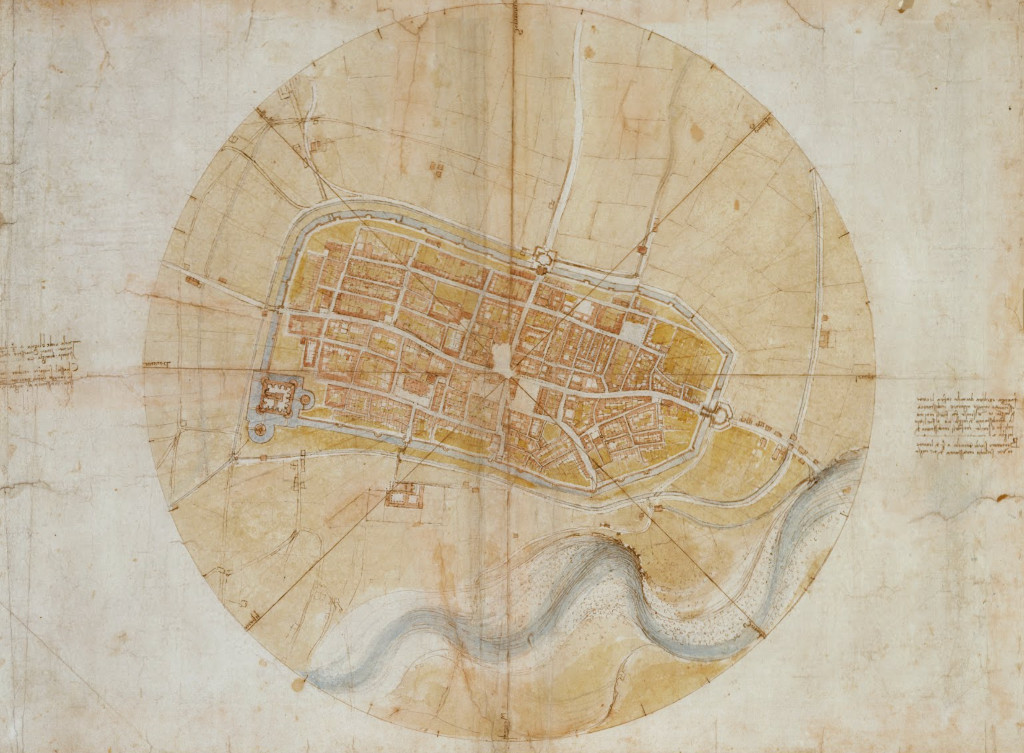Leonardo da Vinci was fascinated by how things worked and why. Da Vinci's inventions are amongst his most significant legacy as a Renaissance master.
Throughout his lifetime, his notes would include all manner of curious sketches across different genres, with comments and observations scrawled alongside them.
Introduction
In becoming an inventor, Leonardo was merely extending his interest in the workings of the human anatomy towards all manner of machinery. He liked to reduce complex things down to their component parts, building an understanding of how each element interacted with each other. He believed that human and animal anatomy represented the complexity of the world as a whole, and that much could be learnt through his studies.1
The artist brought extraordinary creativity into the discipline of science and invention, bringing in fresh new ideas as well as tweaking existing ones. He also realised that employment as an engineer could bring considerable benefits to his studio, helping to finance his large team of assistants and also having more resources for ambitious projects.
Da Vinci's inventions can be categorised into two main topics, namely military weapons and transport, with some of his ideas spreading across the two. His flying machines, such as an ornithopter and a form of helicopter, are perhaps the best known from his decades of discovery and experimentation.
Da Vinci famously was unable to bring his inventions to life, in the main, but there was still a considerable legacy to his ideas, which helped to shape the field of engineering in later centuries. Enthusiasts have also developed his ideas into working prototypes over the past century, proving the sound scientific ideas that lay behind his drawings.
Leonardo da Vinci, initially, was only known as a painter, and it took several centuries before his career was looked at in a more rounded, comprehensive manner. His many notes have been collated and documented, which was an important part in this transition, and few artists have now received as much research time as Leonardo.
Lying behind the stunning, often highly detailed drawings was a exceptional understanding of the fundamentals of engineering. This is underlined by examples of his use of leverage/cantilevering, pulleys, cranks, gears, lubrication systems and bearings, among other things. He also understood the history behind various inventions, and their latest design fashions.
This article examines Leonardo da Vinci's inventions in considerable detail, tackling each field in which he was involved, and giving examples of specific things that he created. We will examine the issues that he faced in designing different products, and consider how likely they would have been to work in the present day. There is also information about his movements around Italy, and how that impacted his scientific studies.
Table of Contents
- Introduction
- Famous Inventions by Leonardo da Vinci
- Aspiration for Human Flight
- List of Leonardo da Vinci Inventions by Date
- Leonardo as a Military Engineer
- Leonardo as a Hydraulic Engineer
- Evolution in Map Design
- Frequently Asked Questions
Famous Inventions by Leonardo da Vinci
Some of Leonardo's most famous inventions are included below, with the majority of them being either flying machines or weapons of war. Leonardo would often merge different ideas together, or switch to another idea when he came up against issues that he was unable to resolve. Many of the engineering methods used in his designs would continue to be utilised by other engineers all the way up to the present day, with some modern-day machines still closely resembling some of the drawings shown below.
Aspiration for Human Flight
Leonardo's study of birds became almost obsessional. He would sit in the hills around Florence observing their every detail. He learnt to understand precisely their method of flight, and found variations from one species to the next. This experience pricked his interest in human flight, and he desired to re-create this feat of nature for the benefit of humanity.
The engineer attempted, for many years, to produce a form of ornithopter, where humans would remain airborne by repeatedly flapping a wing-like structure. He understood the differences in weight and design of birds and humans made this approach unworkable, and so he moved on to alternative solutions, including a pedal-controlled version, and then a less ambitious glider.
Leonardo was entirely hampered by the lack of light materials available during the Italian Renaissance, and many of his flying machines displayed clear, sound thinking from an engineering point of view, but would only be effective in later centuries. A number of enthusiasts in the 20th century have proven this point, in a number of successful flights, mainly in Europe.
List of Leonardo da Vinci Inventions by Date
In order to better illustrate the timeline around his discoveries and experiments, we have included a list of Leonardo da Vinci inventions below, which is ordered by date1. It is important to mention that the precise years given are approximate, as most collated drawings and notes cannot be precisely dated.
| Date | Invention |
|---|---|
| 1482 | Multi-barrelled Guns |
| 1485 | Parachute |
| 1485 | Treadmill Machine Gun |
| 1485 | Giant Crossbow |
| 1485-1488 | Armoured Car |
| 1485-1487 | Flying Machine with Steering Device |
| 1487 | Helicopter |
| 1495-1499 | Two Mortars with Explosive Shells |
| 1500 | Diving Suit |
| 1502 | Maps of Imola |
Leonardo as a Military Engineer
The mid to late 1480s marked an important period in Leonardo's work as an inventor. He was based in Milan at this time and although we are unsure as to how he financed his large studio during this period, we do have a plethora of drawings which provide all manner of different ideas for war machines and weapons.
Whilst art historians only treated him as a painter for several centuries, whilst in the court of Milan, Leonardo within his own lifetime was well regarded in a variety of disciplines, including engineering. His knowledge of the human anatomy was well known too. It was only once his drawings had been collated into codex publications that we became aware of this again in more recent centuries.
Having completed Virgin of the Rocks in around late 1484, Leonardo seems to have taken a break from the visual arts, focusing instead on invention and also architecture until the end of the decade. His interest in engineering can be traced back to his early thirties, but this was the first period in which he spent considerable amounts of time focused on this discipline.
In order to become a self-taught inventor, Da Vinci would travel around Italy studying existing machinery and weapons, looking to understand how they worked, but also to consider how they might be improved upon. His knowledge around the workings of nature, particularly the flow of water, would also be used as inspiration for his inventions.
One of the strengths of Leonardo as a painter was his skills of observation, which allowed him to replicate incredible, life-like detail in famous artworks such as Mona Lisa and Ginevra de' Benci. This ability also translated into engineering, enabling him to break designs down into component parts, building an understanding of how each part contributed to the whole.
"...In case of a siege, I know how to dry up the water of the moats and how to construct an infinite number of bridges, covered ways, scaling ladders, and other machines for this type of enterprise..."
Leonardo wrote to Duke Sforza on several occasions, talking up his new-found ability as an engineer, and offering himself for employment in the defence of the realm. Whilst continuing to invent, he was not accepted into the fold and tried his luck in Venice and Florence too. By this stage, Leonardo was continuing to talk up his qualities as an inventor, but was not being given the opportunity to build them into working prototypes.
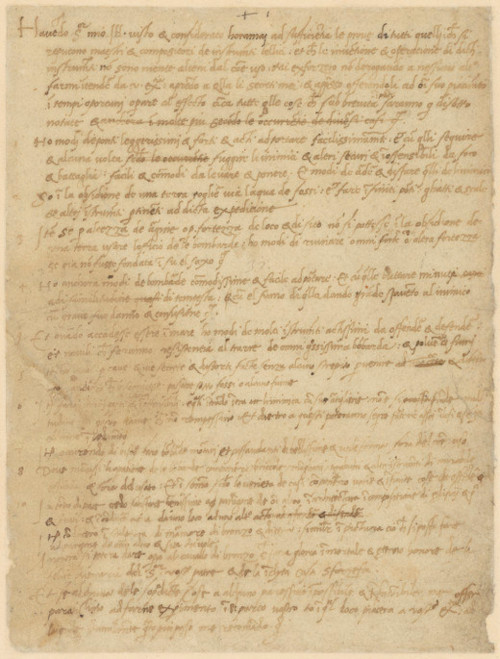 Letter to Ludovico Sforza seeking Employment as an Engineer
Letter to Ludovico Sforza seeking Employment as an Engineer
In 1502, his chance finally came and Leonardo was employed as a military engineer. Cesare Borgia brought him in as chief military engineer, with his role encompassing large amounts of travel around the Italian provinces, studying the approaches taken by other regions in the name of defence. As a pacifist, this would have appealed to Da Vinci as he detested bloodshed, despite the large number of weapon inventions that he produced.
After only a year or two in this role, Da Vinci would return to Milan, where he would set about completing a number of his most famous paintings, including the Mona Lisa. It was then that his focus switched back to the visual arts, after producing hundreds of engineering drawings and studying every aspect of military warfare that one could imagine.
Leonardo as a Hydraulic Engineer
Leonardo da Vinci was something of a salesman whilst in the earlier phases of his development as an engineer. He famously claimed to be able to "guide water from one place to another" in his early dealings with Ludovico Sforza2, even though he had no experience as a hydraulic engineer at that point. The artist would often makes fantastical claims which could not be backed up at the time, but he knew that his ability would cover over the cracks in his knowledge, were he to be given a chance.
He invented an ambitious plan in 1503 to redirect Arno River away from the city of Pisa, leaving it vulnerable. He believed that this plan could allow his new employers in Florence to claim the city without any need for a battle. This idea would have been inspired by his time in Milan, which had enjoyed a complex and successful network of waterworks for many centuries. Sadly, Leonardo's detailed plans were not implemented correctly and the project failed. Despite this, Leonardo retained his interest in connecting Florence to the Mediterranean Sea2.
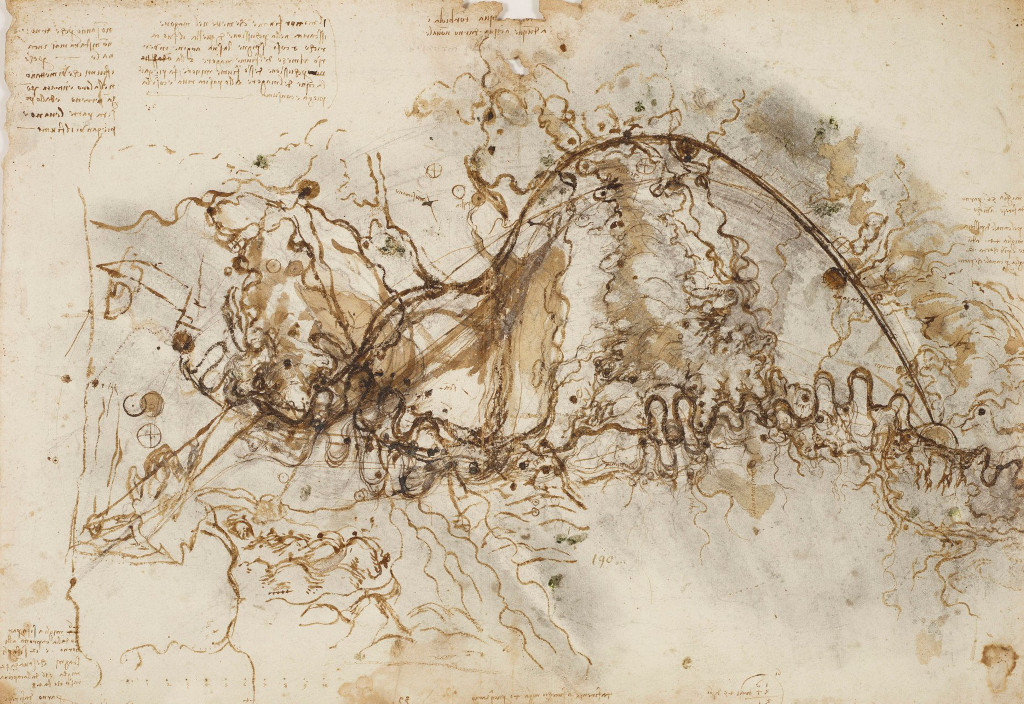 Canal Design to Re-Route Arno River
Canal Design to Re-Route Arno River
Evolution in Map Design
Leonardo brought new ideas to map design, and used his artistic eye to improve their use to military leaders. A greater use of colour and clever methods of displaying information would bring advantages to military tacticians as they planned their offensive strategies. His map of Imola is particularly famous, and serves as an artwork in its own right.
The specific elements of Leonardo's maps that made them so innovative included more precise measurements of distances, as well as greater detail which included individual houses within his map of Imola. The variations in colours allowed people to quickly differentiate between rivers, roads and houses.
Da Vinci's maps could be considered one of his biggest influences on warfare, and evidence suggests that were used at the time by his employers. The angle of a bird's-eye view was also unusual for a city map up to that point, but is now entirely conventional in the modern era.
Frequently Asked Questions
See below for some frequently asked questions and answers on the topic of Leonardo's inventions. The topic continues to excite and interest budding engineers, as well as enthusiasts around Da Vinci's life in general. Most information derived on his work as an engineer has come from his codex publications which have brought together thousands of pages of notes and sketches from his career.
Did Leonardo's Inventions actually work?
Leonardo could not turn his ideas into working prototypes during his own lifetime. Many of his inventions were way ahead of their time, and could only succeed when combined with modern engineering practices and lighter materials.
What were Leonardo's Most Famous Inventions?
Leonardo da Vinci's ornithopter, a flying machine which simulates a flapping-bird motion, is his most famous invention. He produced a number of study sketches for it, and it is legend that he forced an assistant to test it from a steep hill in Tuscany.
When did Leonardo work as a military engineer?
Leonardo da Vinci worked as a military engineer between the years of 1500-1503 for Cesare Borgia. He had been producing inventions for military weapons and flying machines since the mid-1850s as part of his personal studies.
Are there any Da Vinci Inventions that we use today?
Leonardo's "inventions" never evolved into working prototypes, but his creative ideas may well have influenced some of the items that we continue to use today, such as the ball bearing, parachutes, the machine gun and diving equipment.
References
- Leonardo. The Complete Paintings and Drawings, Frank Zöllner & Johannes Nathan, Taschen
- Leonardo da Vinci, Walter Isaacson
- The Science of Leonardo, Fritjof Capra



